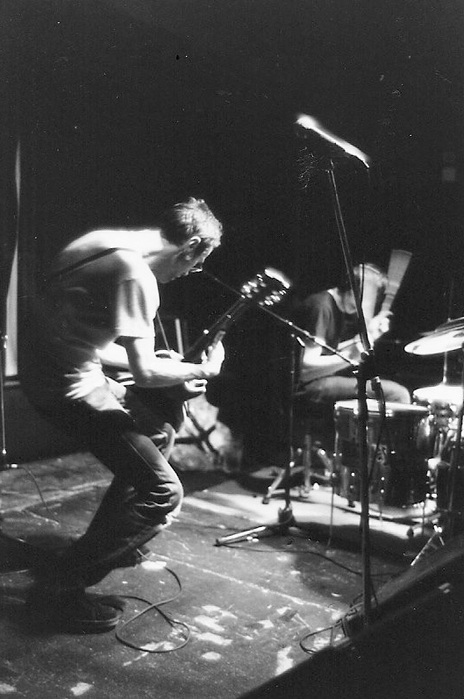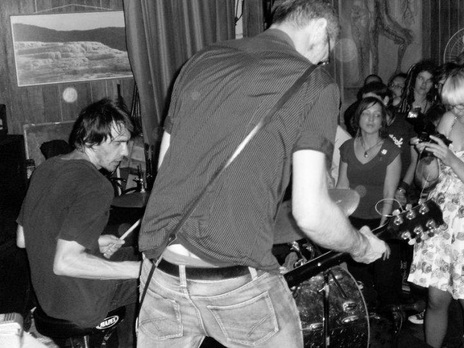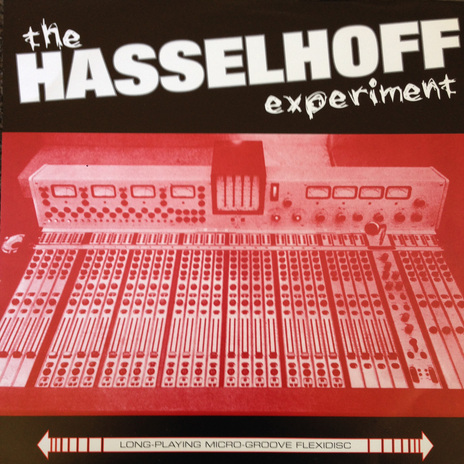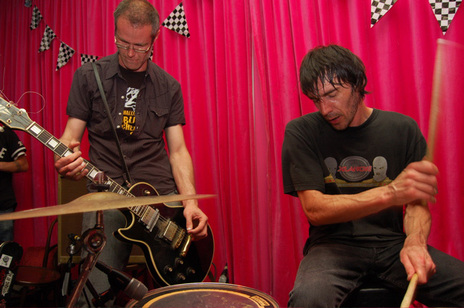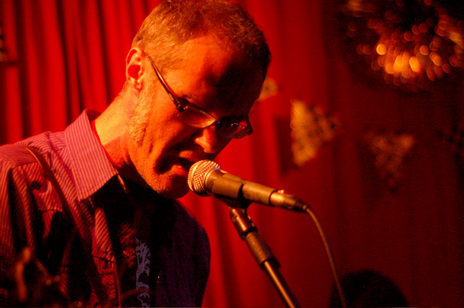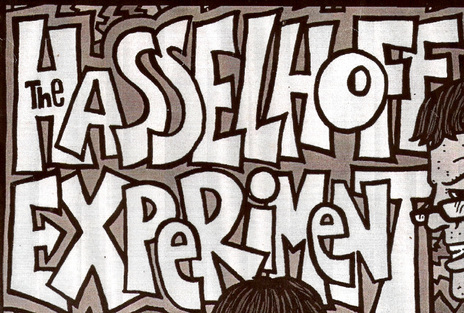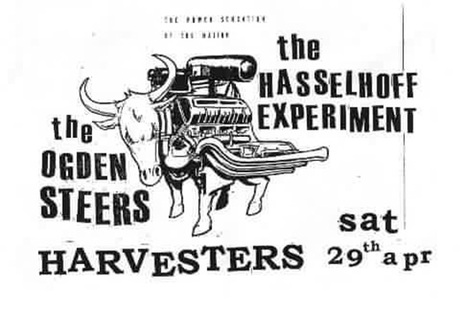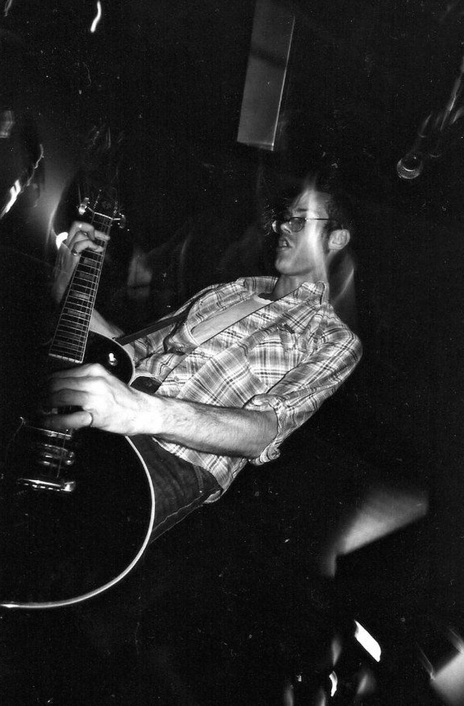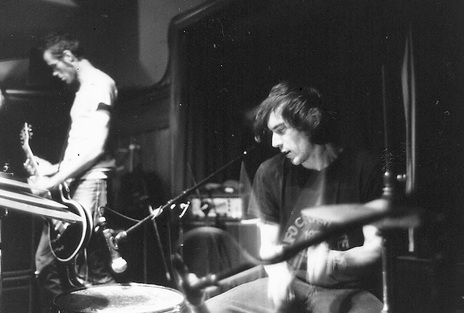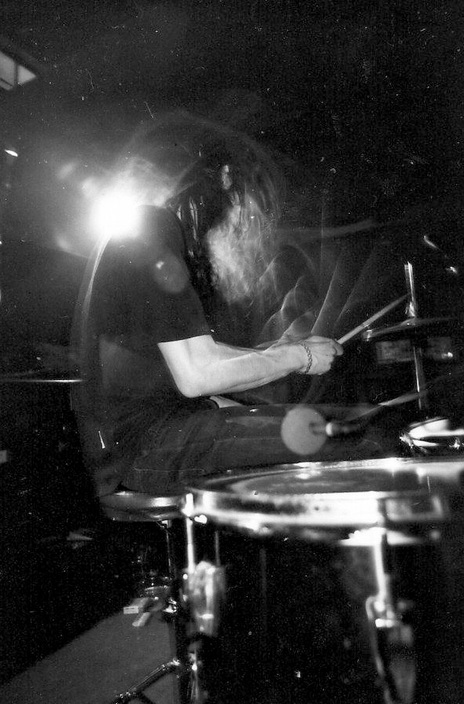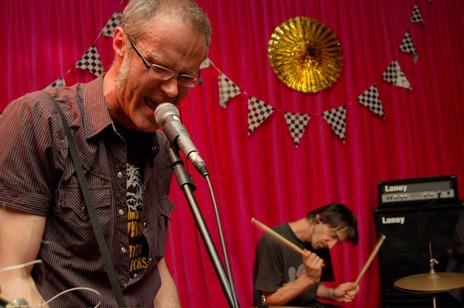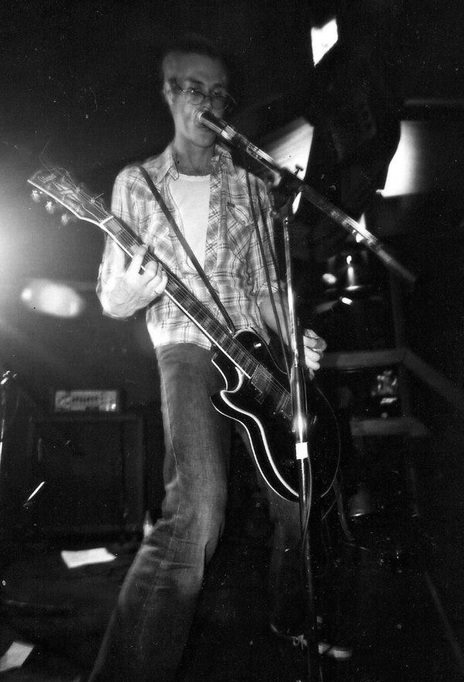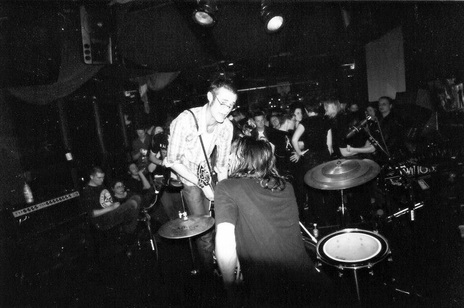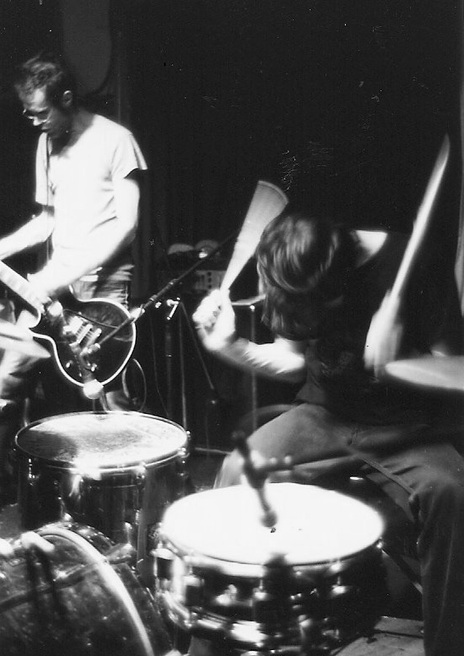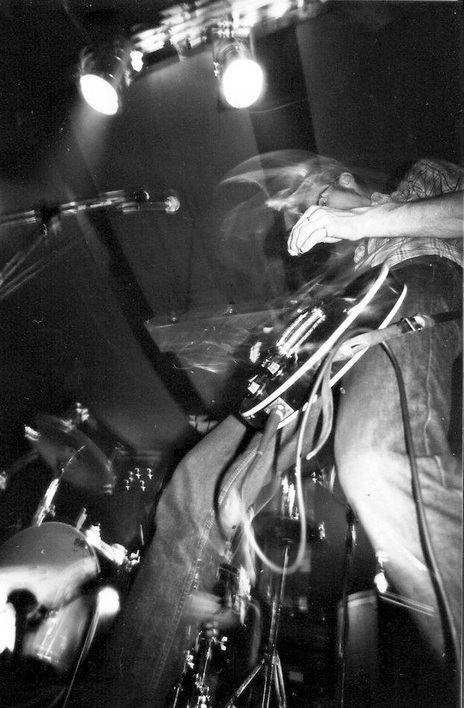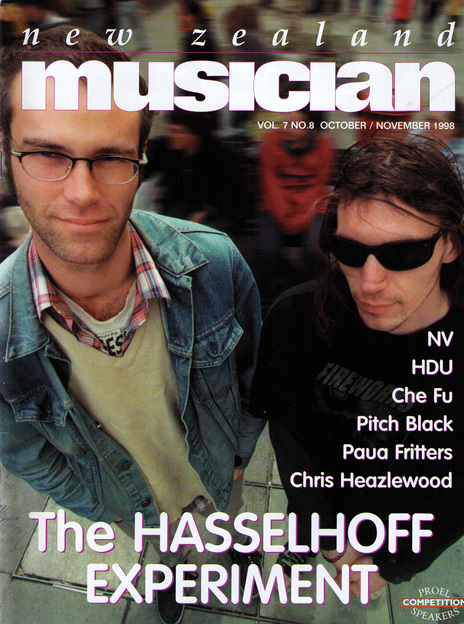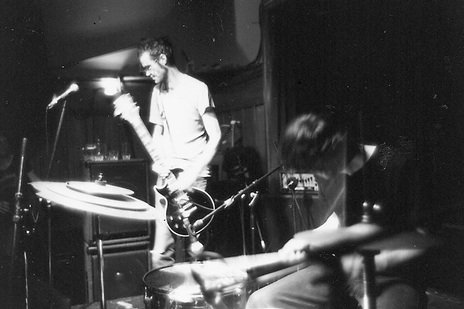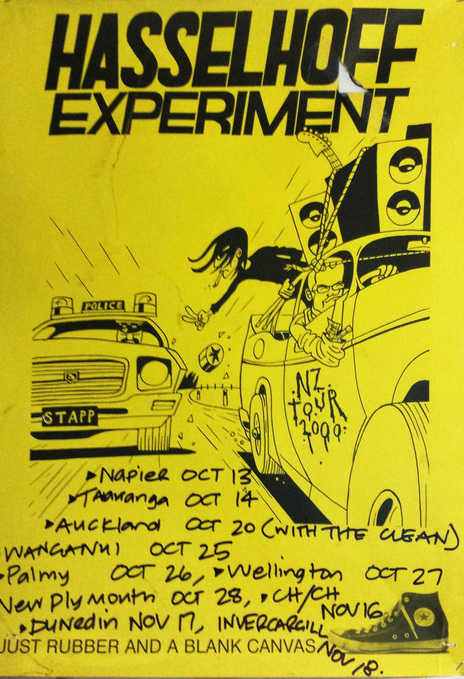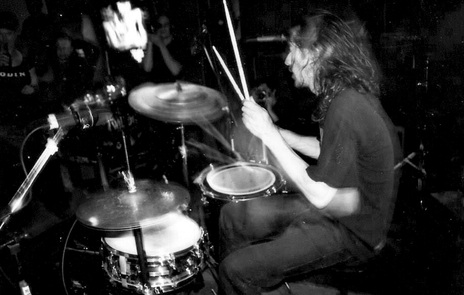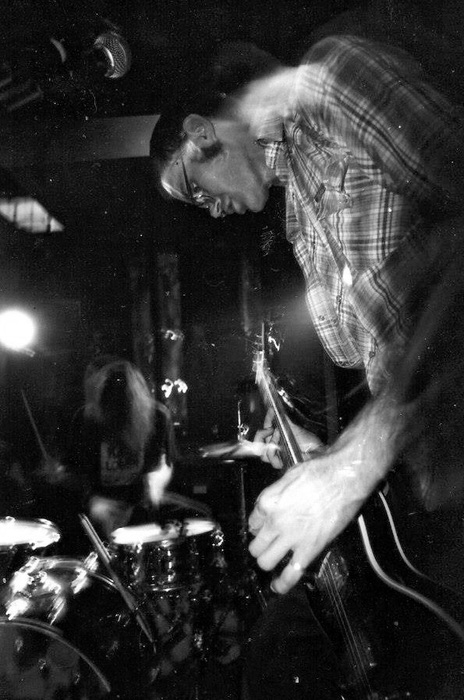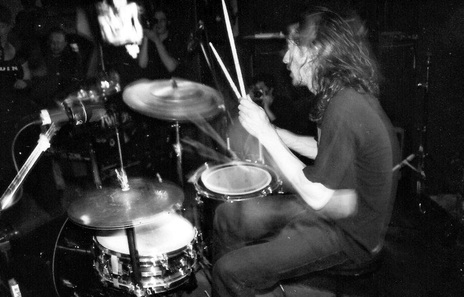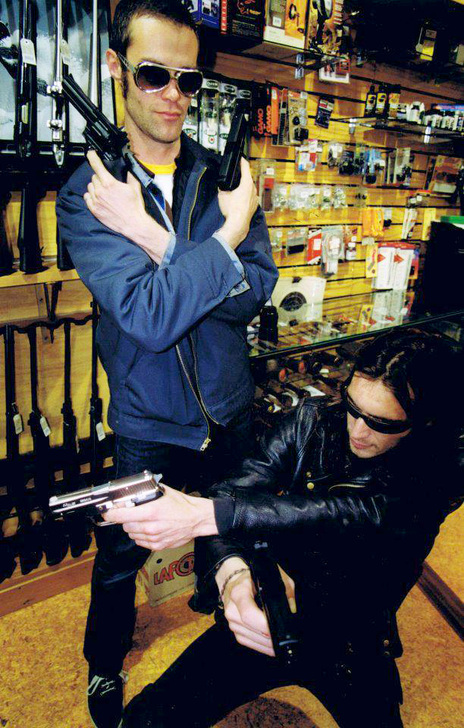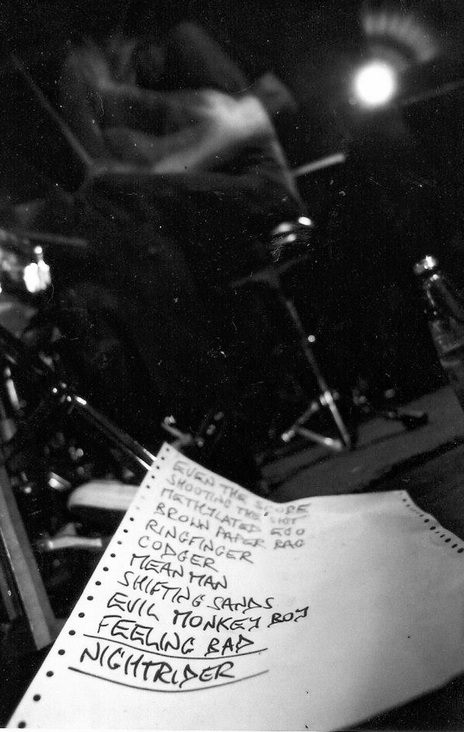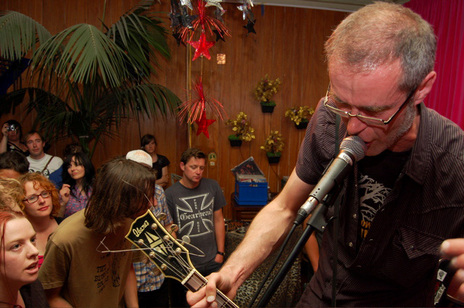The increasing popularity of electronic music in the 90s saw the closure of many live venues throughout the country and diminished the popularity of rock music. All this only served to make The Hasselhoff Experiment’s revival of rock’s primordial underbelly more exciting.
Stripped back to the basics of guitar, vocals and drums, live performances by the duo presented a spectre of understated intensity.
Stripped back to the basics of guitar, vocals and drums, live performances by the duo presented a spectre of understated intensity: guitarist and singer Andrew Tolley’s gangly frame looming over his microphone, barking out lyrics while his guitar hung somewhere down below his knees.
Meanwhile, beside him at the front of the stage, drummer Brendan Moran suffered over his simplified kit, head bowed as if burdened near the limits of his strength. The Hasselhoff Experiment never made it look easy. But it was these qualities combined with an absence of unnecessary posturing that aroused and impressed audiences.
In was no surprise that The Hasselhoff Experiment could emerge so fully formed. Both Moran and Tolley had come to the band as veterans of the Wellington scene. Tolley had played in Hustler and Jawload, both of whom had toured nationally with Shihad and Head Like A Hole while Moran had been in Dome and Cattle. The pair had previously played together in Sowpuss and following that band’s demise, formed The Hasselhoff Experiment in 1997.
Out of the Sandpit
The first six months were typified by perfecting their craft as a live band. “We played a fair bit in Welly,” says Tolley, in his typically modest and understated manner, “with everyone we could: metal bands, Flying Nun bands, indie bands … mainly at old Bodega and Hole in the Wall.” This rigorous road testing of material meant that by October 1997 the band was able to spend two days at Inca Productions (located in an old BNZ bank vault) with Mike Gibson and walk away with a completed record.
Opting to maintain creative control, The Hasselhoff Experiment self-released the album in 1998 on Andrew Tolley’s Kato label. In a move that was both a clear artistic and aesthetic statement, the album was pressed to vinyl: a bold and unusual occurrence in the CD-saturated 90s.
1998 would prove to be a watershed year for The Hasselhoff Experiment. Proactively, the band cast their net wider by playing shows outside of Wellington. It was their appearances in Auckland in particular that made waves, successfully winning over fans and fellow musicians alike in that city’s larger scene. Ultimately they attracted the attention of Flying Nun’s Paul McKessar.
“Hasselhoff Experiment were a great live band,” says McKessar, who quickly perceived the band’s independent streak, “It wasn’t so much a signing. They were mostly into the vinyl but we said, look people like your band and that is almost sold out so why don't we do a CD as well? We wrote up a little one page contract and that was that.”
Similarly McKessar made an insightful assessment of The Hasselhoff Experiment’s position in the music industry: “I thought we’d sell albums … I wasn’t thinking about them being played on commercial radio. They were a good band, touring as much as they could, doing fun promo, getting played plenty on the B-Nets and we were exporting copies overseas.”
Throughout the year, the band’s presence steadily increased, thanks not only to their potent music and touring but also through the efforts of their talented manager, Angela Means. The B-Nets proved especially supportive, not just through airplay but also by naming The Hasselhoff Experiment “Best New Act” at the 1998 B-Net Awards. The pair also graced the cover of October’s NZ Musician and made numerous television appearances on music shows, including Space, Ground Zero and the Havoc Show.
Even at low speed, the velocity was sufficient to send Tolley, the cameraman and sound engineer flying across the flatbed.
Mikey Havoc, then at a peak of his media presence, was a particular advocate of the band. In an effort to irritate the retirees of Orewa, Havoc suggested the band play on the back of a flatbed truck while cruising the streets of that quiet beachside town. However, things did not go according to plan: in an episode Tolley describes as “Keystone Cops” while turning through a roundabout a PA speaker fell from the truck, smashing to pieces on the road. Noticing this, the driver instinctively braked. Even at low speed, the velocity was sufficient to send Tolley, the cameraman and sound engineer flying across the flatbed, narrowly avoiding impaling themselves on Moran’s drum hardware.
Shifting Sands
By 1999, Moran had relocated to Auckland while Tolley remained in Wellington. As a result, production of their sophomore effort Always Outnumbered Always Outgunned (a reference to Walter Mosley’s crime novel of the same name) was split between Inca Productions in Wellington with Mike Gibson and The Lab in Auckland with Matthew Heine (S.P.U.D/Solid Gold Hell) at the controls.
The album was again issued on vinyl, pressed at Corduroy Records in Melbourne, maintaining the band's sonic aesthetic while Flying Nun released a CD edition, catering to those who no longer owned a record player.
The Hasselhoff Experiment’s dedication to live performance continued throughout their career. Extensive national touring reached as far south as Invercargill and many parts in between. When on the road, the band often enjoyed the company of Palmerston North’s The Flamin’ Werepigs but were not averse to playing second fiddle to more established acts like HLAH. Their reputation as a great live act saw them open for international acts Jesus Lizard, Bob Log III, Tomahawk and The Jon Spencer Blues Explosion.
Their reputation as a great live act saw them open for international acts Jesus Lizard, Bob Log III, Tomahawk and The Jon Spencer Blues Explosion.
While enthusiastically embraced in New Zealand, Australia would prove less welcoming for The Hasselhoff Experiment. An initial showcase at a suburban bar in Melbourne at the turn of the century was disappointing. Returning a year later, the band played around Melbourne more extensively, including a gig with Rowland S. Howard. It was at this show that the band's sound engineer James Woods (now the bassist in Beastwars) incurred the wrath of the venue management. A difference of opinion over volume was met with stubborn insistence that there would be no compromise on Wood’s behalf, lest he do the band a great disservice. The venue packed out and come showtime, Woods pushed his luck and the PA. His instincts were right and the show proved to be The Hasselhoff Experiment’s best across the Tasman.
Gone Baby Gone
If the first half of The Hasselhoff Experiment’s history can be characterised as meteoric, then it is of little surprise that 2000 saw a change in pace. Andrew Tolley finally relented and moved to Auckland. However, the transition proved more difficult than expected, causing distractions (such as finding employment) that weakened his focus on the band. Similarly, Brendan Moran was now drumming with The Subliminals, which, while not causing any interpersonal friction, was effectively dividing his time.
Furthermore, Moran was keen to relocate with his partner to the USA and make a go of the band there. But Tolley found he lacked the enthusiasm for such a venture and his interest in the band was not what it had been. Compounding this was the growing unarticulated suspicion that the band had fully explored the limits of the two-piece formula.
Out Of The Sandpit And On To The Drive would prove to be the band’s final album. Recorded in PA company Acme Audio’s workshop and engineered by Brendan’s brother Paddy Moran and reputable Dunedin engineer Tex Houston, The Hasselhoff Experiment’s final effort reflected the band’s waning vitality. Tolley explains: “The last album I never really felt was as good as it could have been. I was throwing in old songs from other bands, and coming up with songs pretty quickly in a piecemeal fashion just to make sure we had enough songs for an album.”
While the record may have been unsatisfactory, it was accompanied by one of just two videos that The Hasselhoff Experiment made. Directed by Back Of The Y's Chris Stapp and Matt Heath, ‘Drag Racer’ was an excellent pairing of the band’s garage DIY aesthetic with the filmmakers’ totally absurd B-grade visual effects and gags.
The final live appearance, at bFM's Summer Series in early 2002, was a lesson in disorganisation.
Symptomatic of the band’s diminishing momentum, the final live appearance, at 95bFM’s Summer Series in early 2002, was a lesson in disorganisation. Owing to Moran’s generous nature, the components of his drum kit had been lent out all over town. Lacking a vehicle or the ability to drive, Moran waited patiently for Tolley to arrive to commence collection. This proved time consuming. Arriving literally minutes before their set time, the band received a frosty reception from event organisers. Perhaps motivated by frustration, a blistering set resulted but true to cliché the writing was on the wall.
By mid-2002, Moran had finally departed for the USA and The Hasselhoff Experiment effectively ground to a halt. When he returned to New Zealand, there were sporadic reunion shows during 2007 to 2009 but the band never quite recaptured their initial drive or enthusiasm. Ultimately, Moran made the decision to curtail his musical activities in favour of a fine arts degree. Andrew Tolley has continued to organise shows and make music in numerous guises since then.
Cast Your Shadow
Like comedy, in music, timing is everything. The Hasseloff Experiment emerged at just the right time to encapsulate a particular moment in New Zealand music. While they were not alone in their appreciation of garage punk, their stripped back and DIY approach distinguished them as a unique. Even as a hard and abrasive band, they still achieved a high degree of success over a small period. While their successors such as The D4 and The Datsuns were able to gain a broader appeal, The Hasselhoff Experiment left an indelible mark. In essence, they were pivotal in drawing attention to and opening a new vein of New Zealand independent rock music distinct from the Dunedin sound.
